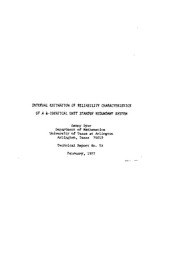
ATTENTION: The works hosted here are being migrated to a new repository that will consolidate resources, improve discoverability, and better show UTA's research impact on the global community. We will update authors as the migration progresses. Please see MavMatrix for more information.
Show simple item record
| dc.contributor.author | Dyer, Danny D. | en |
| dc.date.accessioned | 2010-05-25T21:19:06Z | en |
| dc.date.available | 2010-05-25T21:19:06Z | en |
| dc.date.issued | 1977-02 | en |
| dc.identifier.uri | http://hdl.handle.net/10106/2159 | en |
| dc.description.abstract | **Please note that the full text is embargoed** ABSTRACT: Standby redundancy is a method for increasing the reliability of a system through the use of additional "backup" units. Assuming perfect failure-sensing and switch-over, we consider such a system when the units are identical, non-repairable, and their lifetimes follow a two-parameter exponential distrubution. Based on unit Type II censored data, interval estimates of the system threshold parameter, mean time to failure, and reliability at time [see pdf for notation], are made through structural inference (a group theoretic approach to fiducial theory). A discussion of n-content structural tolerance intervals for the distribution of the lifetime of the system is also given. The design of a redundant system is considered by developing an algorithm which will give the minimum number of standby units required so that, with probability at least [see pdf for notation], the system reliability at time [see pdf for notation] is at least a [see pdf for notation]. Numerical examples are given to illustrate the theory. | en |
| dc.language.iso | en_US | en |
| dc.publisher | University of Texas at Arlington | en |
| dc.relation.ispartofseries | Technical Report;53 | en |
| dc.subject | Standby redundancy | en |
| dc.subject | Two-parameter exponential | en |
| dc.subject | Structural inference | en |
| dc.subject | System design | en |
| dc.subject | Tolerance bounds | en |
| dc.subject | Interval estimates | en |
| dc.subject.lcsh | Mathematical statistics | en |
| dc.subject.lcsh | Mathematics Research | en |
| dc.title | Interval Estimation of Reliability Characteristics of a k-identical Unit Standby Redundant System | en |
| dc.type | Technical Report | en |
| dc.publisher.department | Department of Mathematics | en |
Files in this item
- Name:
- MathTechReport053.pdf
- Size:
- 832.2Kb
- Format:
- PDF
- Description:
- PDF
This item appears in the following Collection(s)
Show simple item record


